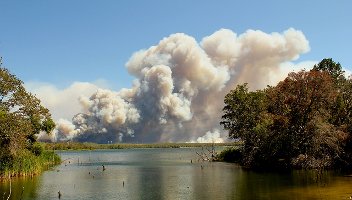
Back in the first week of September, a large part of the very large state of Texas was on fire. There was so much fire that the Texas Department of Transportation had a live fire map on their website. It showed many small animated flames scattered around the state, and one really enormous campfire-sized flame in Bastrop County, about 35 miles away from my home in Austin.
Local news compared the size of the Bastrop fire to the state of Connecticut. Its smoke plume was visible from space. Satellite photographs showed a dark point that widened as it traveled south until it trailed away in a ragged, fanned out fringe into the Gulf of Mexico. In Austin, we could see great black clouds of smoke on the horizon and, later, a gray-white sky. And of course, we could smell it.
Because scent is invisible to the naked eye, we tend to think of it as intangible. Once, I even saw an announcement for an academic forum on smell and architecture that referred to odor as “abstract.” But though we might not be able to hold an aroma in our hands, every time we smell something we’ve come in direct, intimate contact with tiny bits of it…



